Allergies to seafood, particularly fish and shellfish, are relatively common and can vary significantly in their presentation and severity among individuals. While some people may experience allergic reactions to both fish and shellfish, others may be allergic to only one type. This article delves into the reasons behind why some individuals are allergic to fish but not shellfish, exploring the distinct proteins, immune responses, and genetic factors involved.
Different Protein Profiles
Fish Protein Composition
Fish and shellfish belong to distinct taxonomic groups and possess different protein profiles, which can influence the likelihood of triggering allergic reactions. Fish proteins are diverse and can vary depending on the species, but some common allergenic proteins include parvalbumins, tropomyosins, and collagen. Parvalbumins, in particular, have been identified as major allergens in various fish species and are known to elicit allergic responses in sensitive individuals.
Shellfish Protein Composition
In contrast, shellfish encompass a broader category that includes crustaceans (e.g., shrimp, crab, lobster) and mollusks (e.g., clams, mussels, oysters). The primary allergens in shellfish are tropomyosins, which are structural proteins found in muscle tissue. Tropomyosins are highly conserved across different shellfish species and are recognized as major allergens responsible for allergic reactions in shellfish-allergic individuals.
Immunological Specificity
The distinct protein compositions of fish and shellfish contribute to the immunological specificity observed in seafood allergies. Individuals sensitized to fish allergens, such as parvalbumins, may exhibit allergic reactions upon exposure to various fish species, regardless of their taxonomic classification. Similarly, those allergic to shellfish tropomyosins may react to different types of shellfish due to the conserved nature of these allergenic proteins.
Cross-Reactivity and Allergenic Proteins
Cross-Reactivity in Seafood Allergies
Cross-reactivity refers to the phenomenon where antibodies produced in response to a specific allergen recognize similar proteins in different substances, leading to allergic reactions. In seafood allergies, cross-reactivity can occur between allergenic proteins in fish and shellfish, contributing to the complexity of diagnosis and management.
Tropomyosin Cross-Reactivity
Tropomyosins, as major allergens in both fish and shellfish, are known to exhibit cross-reactivity. Individuals allergic to shellfish tropomyosins may demonstrate cross-reactivity with certain fish species that contain structurally similar tropomyosin proteins. However, the extent of cross-reactivity can vary among individuals, and not all shellfish-allergic individuals will react to fish, and vice versa.
Parvalbumin Cross-Reactivity
Parvalbumins, on the other hand, are specific to fish and are not found in shellfish. While cross-reactivity between fish parvalbumins and shellfish tropomyosins is less common, some studies have reported instances of cross-reactive IgE antibodies in individuals with seafood allergies. However, the clinical significance of this cross-reactivity remains a subject of debate and requires further investigation.
Distinct Immune Responses
Role of Immunoglobulin E (IgE)
Allergic reactions to seafood, including fish and shellfish, are mediated by the immune system’s production of immunoglobulin E (IgE) antibodies specific to allergenic proteins. Upon subsequent exposure to the allergen, these IgE antibodies bind to mast cells and basophils, triggering the release of inflammatory mediators such as histamine, which elicit allergic symptoms.
Sensitization and Symptom Manifestation
The process of sensitization involves the initial exposure to an allergen, during which the immune system produces specific IgE antibodies. Upon subsequent exposures, these IgE antibodies recognize and bind to the allergenic proteins, leading to the activation of mast cells and the initiation of allergic reactions. The manifestation of symptoms can vary in severity and may include skin reactions (e.g., hives, itching), gastrointestinal symptoms, respiratory symptoms, or even anaphylaxis.
Individual Variability
Individual variability in immune responses can influence the clinical presentation of seafood allergies. Some individuals may exhibit immediate hypersensitivity reactions upon ingestion or contact with fish or shellfish proteins, while others may experience delayed reactions or milder symptoms. The underlying mechanisms driving this variability are not fully understood but may involve factors such as genetic predisposition, environmental influences, and co-existing allergic conditions.
Genetic Predisposition
Role of Genetics in Allergies
Genetic factors play a significant role in determining an individual’s susceptibility to allergies, including seafood allergies. Studies have identified several genetic polymorphisms associated with an increased risk of developing allergic conditions, although the specific genes involved in seafood allergies remain incompletely understood.
Gene-Environment Interactions
The development of allergies is thought to result from complex interactions between genetic predisposition and environmental factors. Exposure to allergenic proteins in seafood during critical periods of immune system development may contribute to the development of sensitization and allergic responses in genetically susceptible individuals.
Familial Patterns
Familial patterns of allergies, including seafood allergies, suggest a genetic component in their etiology. Individuals with a family history of allergies, asthma, or atopic dermatitis may have an increased risk of developing seafood allergies due to shared genetic susceptibility factors. However, the inheritance pattern of seafood allergies is likely multifactorial, involving contributions from multiple genes and environmental influences.
Environmental Influences and Sensitization
Early Life Exposures
Early life exposures to allergenic proteins in seafood may play a critical role in the development of sensitization and allergic responses. Infants and young children exposed to fish or shellfish proteins through breast milk, formula, or early introduction of solid foods may be more likely to develop allergies later in life, particularly if they have a genetic predisposition.
Geographic and Dietary Factors
Geographic and dietary factors can also influence the prevalence of seafood allergies in different populations. Regions where fish and shellfish are dietary staples may have higher rates of seafood allergies due to increased exposure to allergenic proteins. Additionally, variations in culinary practices and food processing techniques can affect the allergenicity of seafood products and contribute to differences in allergy prevalence.
Hygiene Hypothesis
The hygiene hypothesis posits that reduced exposure to infectious agents and microbial diversity in early childhood may lead to an increased risk of developing allergies. In the context of seafood allergies, factors such as improved hygiene practices, urbanization, and changes in dietary habits may contribute to the rising prevalence of allergic conditions, including allergies to fish and shellfish.
Diagnostic Considerations and Management Strategies
Accurate Diagnosis
Accurate diagnosis of seafood allergies, including identification of specific allergens responsible for allergic reactions, is essential for effective management. Allergy testing, including skin prick tests and blood tests for specific IgE antibodies, can help identify sensitivities to fish and shellfish proteins. Additionally, oral food challenges may be conducted under medical supervision to confirm or rule out allergies in individuals with ambiguous or conflicting test results.
Avoidance and Allergy Management
The cornerstone of managing seafood allergies involves strict avoidance of allergenic proteins to prevent allergic reactions. Individuals diagnosed with fish allergies should avoid consuming fish and products containing fish-derived ingredients, while those allergic to shellfish should avoid crustaceans and mollusks. Careful reading of food labels and communication with food service providers are essential for avoiding accidental exposure to seafood allergens.
Emergency Preparedness
For individuals with a history of severe allergic reactions (anaphylaxis), carrying epinephrine auto-injectors (e.g., EpiPen) and receiving proper training in their use is crucial for emergency preparedness. Prompt administration of epinephrine can reverse life-threatening symptoms and is the first-line treatment for anaphylaxis. Additionally, individuals at risk of severe allergic reactions should develop personalized allergy action plans in consultation with healthcare providers.
Immunotherapy and Desensitization
Immunotherapy, such as oral immunotherapy (OIT) or sublingual immunotherapy (SLIT), is being investigated as a potential treatment option for certain food allergies, including seafood allergies. These approaches involve gradually exposing individuals to increasing doses of allergenic proteins under medical supervision to induce tolerance and reduce allergic reactions. However, the efficacy and safety of immunotherapy for seafood allergies require further research and clinical evaluation.
Conclusion
Allergies to seafood, including fish and shellfish, are complex and multifaceted conditions influenced by genetic, immunological, environmental, and dietary factors. While some individuals may be allergic to both fish and shellfish due to cross-reactivity or shared allergenic proteins, others may exhibit selective allergies to either fish or shellfish. Understanding the distinct protein compositions, immune responses, and genetic predispositions associated with fish and shellfish allergies is essential for accurate diagnosis, effective management, and the development of targeted therapies for individuals with seafood allergies. Through continued research and clinical advancements, there is hope for improved diagnosis, treatment, and quality of life for those affected by seafood allergies.
[inline_related_posts title=”You Might Be Interested In” title_align=”left” style=”list” number=”6″ align=”none” ids=”9494,9490,9486″ by=”categories” orderby=”rand” order=”DESC” hide_thumb=”no” thumb_right=”no” views=”no” date=”yes” grid_columns=”2″ post_type=”” tax=””]
































